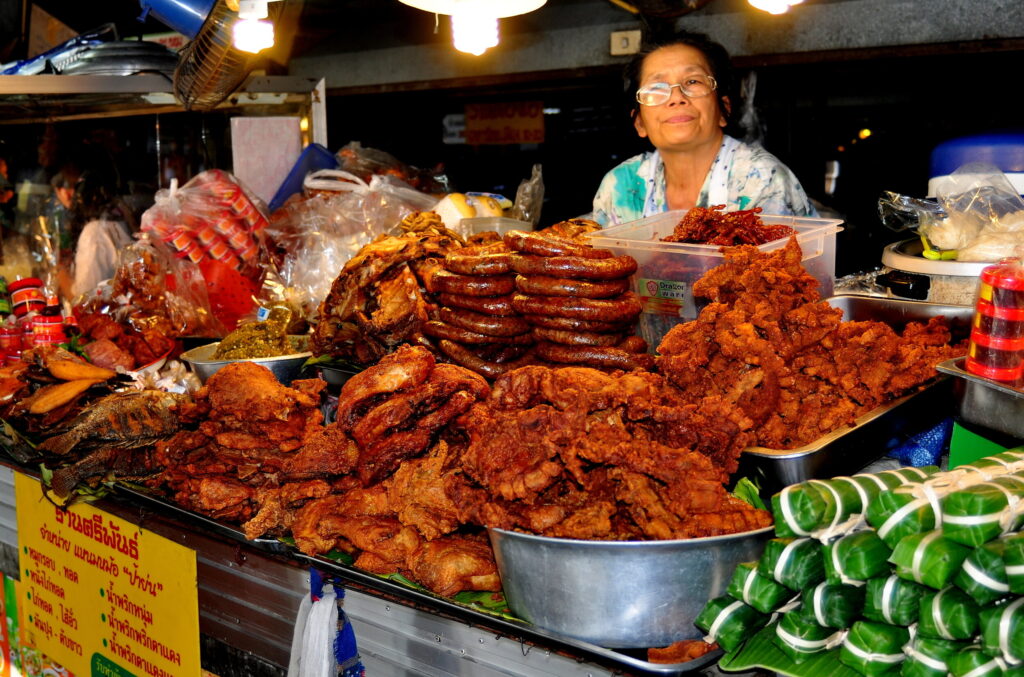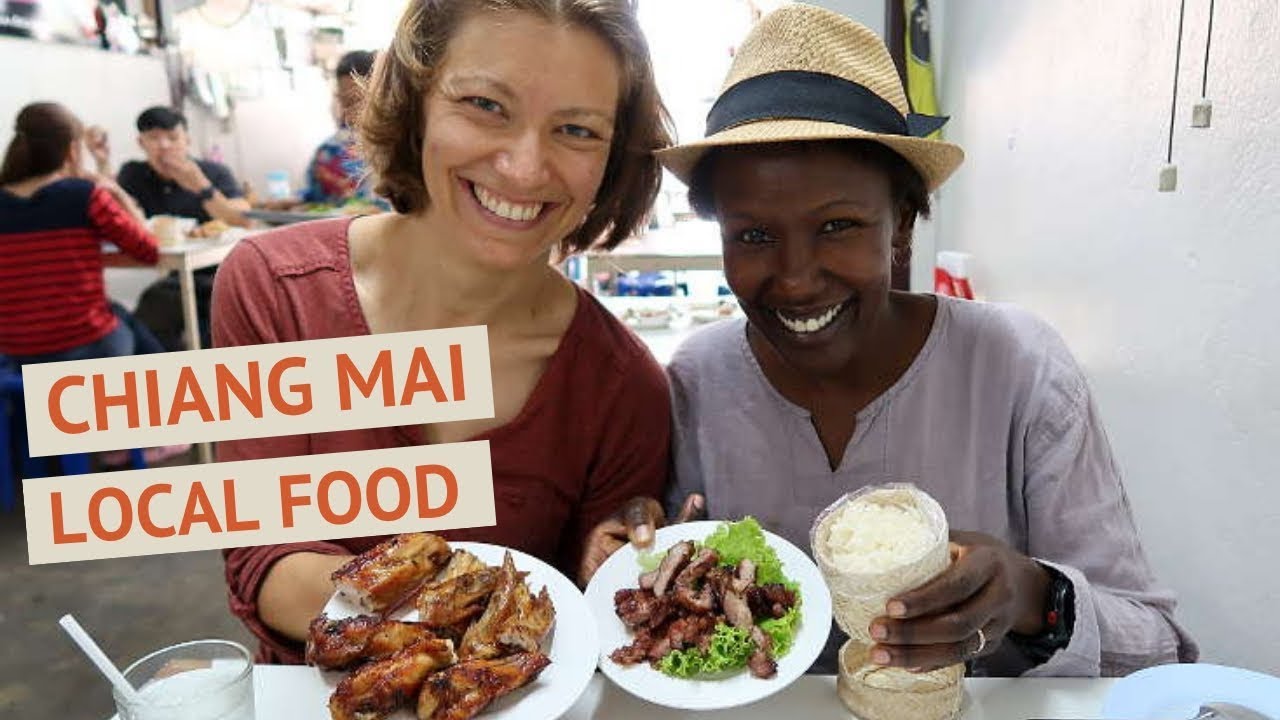If you’ve ever found yourself craving a sensational food adventure, Chiang Mai should be at the top of your travel list. Nestled in the heart of Thailand, this vibrant city not only boasts stunning tourist attractions and picturesque beaches but also a street food scene that is simply irresistible. From aromatic Pad Thai to sizzling skewers of grilled meat, the diverse and mouthwatering flavors of traditional Thai cuisine will leave you craving for more. Join the hordes of food enthusiasts as they navigate bustling markets and night bazaars, immersing themselves in the rich culinary culture of Chiang Mai. So pack your appetite and get ready to embark on a journey of tantalizing flavors and unforgettable street food experiences.
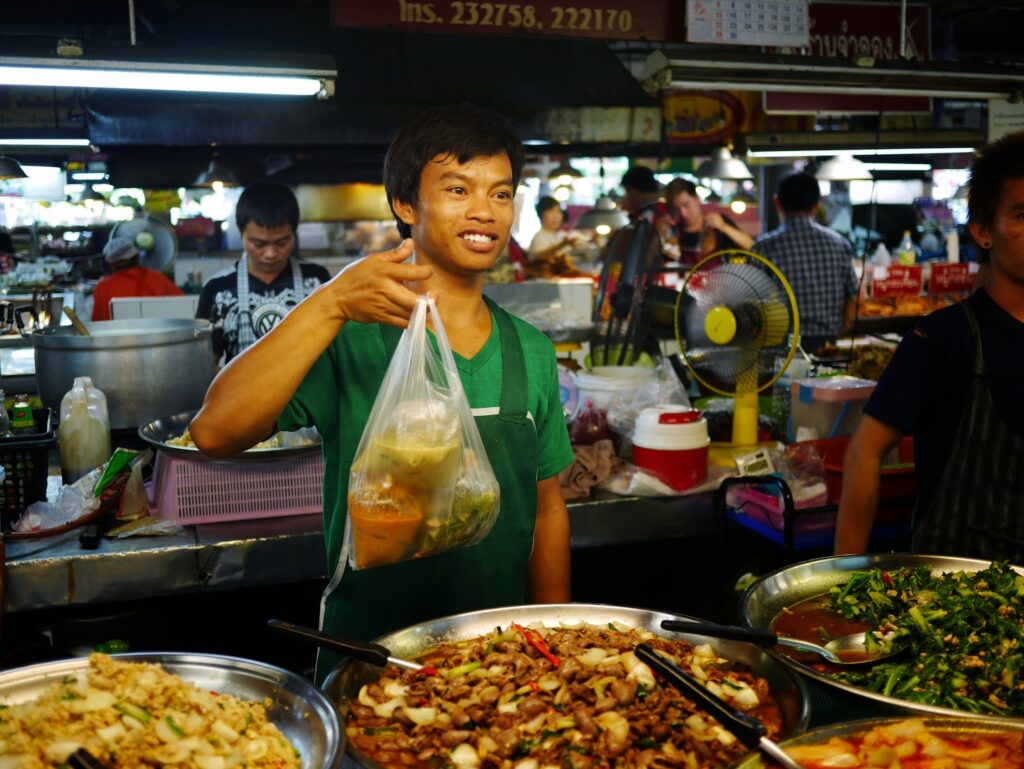
1. Introduction to Chiang Mai’s Street Food Scene
Chiang Mai, located in the mountainous region of Northern Thailand, boasts a vibrant street food scene that is deeply ingrained in its cultural fabric. From bustling night markets to roadside stalls, the streets of Chiang Mai are alive with the aromas and flavors of delicious local cuisine. In this article, we will delve into the cultural significance of street food in Chiang Mai, explore why it is a food lover’s paradise, and discover the popular street food districts in the city.
1.1 The Cultural Significance of Street Food in Chiang Mai
Street food holds immense cultural significance in Chiang Mai, reflecting the rich culinary heritage of Northern Thai cuisine. The locals often embrace street food as a way of life, with many enjoying meals and socializing on the sidewalks of the city. Street vendors take great pride in preserving traditional recipes and cooking techniques that have been passed down through generations. This culinary heritage can be seen in the unique flavors and textures of Chiang Mai’s street food dishes, making it a truly authentic dining experience.
1.2 Why Chiang Mai is a Food Lover’s Paradise
Chiang Mai is a haven for food lovers, offering an impressive variety of flavors and dishes that cater to every palate. The city’s street food scene is bustling with vendors serving up an array of tantalizing treats, from spicy curries and aromatic stir-fries to sweet and savory snacks. Whether you’re a fan of classics like pad Thai and green curry or more adventurous with your taste buds, Chiang Mai’s street food scene has something to satisfy every craving.
1.3 Popular Street Food Districts in Chiang Mai
Chiang Mai is divided into several distinct street food districts, each with its own unique atmosphere and culinary offerings. Some of the most popular districts include the vibrant Night Bazaar area, buzzing with street food stalls and live entertainment, and the bustling Warorot Market, where vendors sell an impressive array of ingredients and ready-to-eat dishes. Other notable districts include Chang Phueak Night Market, Sunday Walking Street Market, Saturday Night Market, Anusarn Market, and Kalare Night Bazaar. Each district has its own charm and specialties, making it worth exploring them all to truly experience the diversity of Chiang Mai’s street food scene.
2. Must-Try Street Food Dishes in Chiang Mai
As you navigate through the streets of Chiang Mai, be prepared to embark on a culinary adventure with these must-try street food dishes:
2.1 Khao Soi
Khao Soi is a quintessential dish of Chiang Mai, featuring a rich and creamy coconut curry broth served with egg noodles and topped with crispy fried noodles. This fragrant and comforting dish is often garnished with pickled mustard greens, shallots, and lime for a perfect balance of flavors.
2.2 Sai Oua (Chiang Mai Sausage)
Sai Oua is a unique and flavorful sausage made from a blend of ground pork, herbs, spices, and fragrant lemongrass. Grilled to perfection, this savory and slightly spicy sausage is a favorite among locals and visitors alike.
2.3 Gaeng Hang Lay (Northern Thai Curry)
Gaeng Hang Lay is a hearty Northern Thai curry that beautifully combines the flavors of pork belly, ginger, tamarind, and a medley of aromatic spices. This sumptuous dish is best enjoyed with a side of steamed rice to soak up the rich flavors.
2.4 Kanom Jeen Nam Ngiao (Northern Thai Noodle Soup)
Kanom Jeen Nam Ngiao is a flavorful noodle soup featuring rice noodles in a tangy and aromatic broth made with tomatoes, pork, and Northern Thai spices. It is often garnished with fresh herbs, pickled cabbage, and crispy fried garlic.
2.5 Khao Kha Moo (Braised Pork Leg on Rice)
Khao Kha Moo is a mouthwatering dish consisting of tender and succulent braised pork leg served over rice. The pork is slow-cooked in a flavorful broth until it becomes melt-in-your-mouth tender, and it is commonly garnished with pickled mustard greens, a boiled egg, and a side of chili vinegar for added complexity.
2.6 Moo Ping (Grilled Pork Skewers)
Moo Ping is a popular street food snack in Chiang Mai, featuring marinated and grilled pork skewers that are juicy, tender, and bursting with smoky flavors. Served with sticky rice and a spicy chili dipping sauce, Moo Ping is a favorite grab-and-go treat.
2.7 Khao Neow Moon (Sweet Sticky Rice with Mango)
No visit to Chiang Mai is complete without indulging in Khao Neow Moon, a heavenly dessert made with sweet sticky rice, fresh slices of ripe mango, and a drizzle of coconut cream. This delightful combination of flavors and textures is perfect for satisfying your sweet tooth.
2.8 Naam Prik Ong (Northern Thai Tomato Chili Dip)
Naam Prik Ong is a fiery chili dip made with ground pork, fermented soybeans, and fragrant tomatoes. The dip is traditionally enjoyed with fresh vegetables and steamed sticky rice, creating a harmonious balance of spicy, tangy, and savory flavors.
2.9 Gai Tod (Fried Chicken)
Gai Tod is a popular street food dish that features crispy and succulent deep-fried chicken, seasoned with a flavorful blend of spices and herbs. This finger-licking dish is often enjoyed on its own or as part of a larger meal.
2.10 Khanom Buang Yuan (Thai Crispy Pancakes)
Khanom Buang Yuan is a delightful snack made with crispy rice flour pancakes filled with a sweet and savory mixture of shredded coconut, mung beans, and a variety of toppings, such as shrimp or coconut cream. These bite-sized treats offer a unique blend of flavors and textures.
3. Exploring Chiang Mai’s Night Markets
Chiang Mai’s night markets are vibrant and lively places where you can immerse yourself in the city’s street food culture. Here are some notable night markets to visit:
3.1 The Charm of Chiang Mai’s Night Market Scene
The night market scene in Chiang Mai is renowned for its vibrant atmosphere and wide variety of culinary delights. As the sun sets, the streets come alive with food stalls, live performances, and local handicrafts. Navigating through the bustling crowds, you’ll discover a treasure trove of flavors and experiences that will leave you wanting more.
3.2 Warorot Market
Warorot Market, also known as Kad Luang, is a bustling and historic market that is a favorite among locals and tourists alike. Here, you can find a diverse range of street food stalls offering traditional Northern Thai delicacies, fresh produce, spices, and ready-to-eat snacks. Don’t miss the opportunity to try the renowned Khao Soi and Kanom Jeen Nam Ngiao at Warorot Market.
3.3 Chang Phueak Night Market
Chang Phueak Night Market is a lively market situated near Chiang Mai University. This market is known for its vibrant street food scene, offering a wide range of local dishes, fresh fruits, and refreshing beverages. If you’re in the mood for something sweet, be sure to try the Mango Sticky Rice or other Thai desserts available at the market.
3.4 Sunday Walking Street Market
The Sunday Walking Street Market, also known as Tha Phae Walking Street, is a must-visit for any avid food lover. Every Sunday, the main road of Tha Phae is transformed into a bustling market where vendors sell a vast array of street food, handicrafts, clothes, and souvenirs. From skewers of grilled meat to mouthwatering pad Thai and crispy fried insects, there is something to entice every palate at this vibrant market.
3.5 Saturday Night Market
The Saturday Night Market, also known as Wualai Walking Street, is another popular destination for street food enthusiasts. This market stretches along Wualai Road and is known for its silverware, traditional crafts, and of course, delicious street food. Satiate your cravings with favorites like Gai Tod (fried chicken), Moo Ping (grilled pork skewers), and a wide range of Thai desserts.
3.6 Anusarn Market
Anusarn Market is located near the Night Bazaar area and offers a lively night market experience. Here, you can sample a variety of street food dishes from Thai to international cuisines. The market is known for its vibrant atmosphere and live entertainment, making it a great place to experience the energy of Chiang Mai’s nightlife while enjoying delectable street food.
3.7 Kalare Night Bazaar
Situated within the Chiang Mai Night Bazaar, Kalare Night Bazaar is a hub for food lovers seeking a wide range of street food options. The market features numerous food stalls serving Thai, Chinese, and international specialties, allowing you to embark on a culinary adventure spanning different cuisines. From spicy curries to dim sum and sushi, the options are endless at Kalare Night Bazaar.
4. Local Food Experiences in Chiang Mai
To truly immerse yourself in Chiang Mai’s food culture, check out these local food experiences:
4.1 Visiting Talat Pratu Chiang Mai Market
Talat Pratu Chiang Mai Market is a hidden gem situated near the Old City walls. This local market is often frequented by Chiang Mai residents, offering a more authentic and less touristy experience. Here, you can immerse yourself in the daily lives of the locals, browse through an array of fresh produce and ingredients, and have the opportunity to sample lesser-known street food dishes.
4.2 Exploring the Wualai Walking Street Market
Wualai Walking Street Market is not only a vibrant night market but also a hub for traditional handicrafts and silverware. In addition to browsing through the local crafts, take the time to explore the street food offerings in this market. You’ll find a variety of local delicacies, including traditional Northern Thai dishes, snacks, and desserts, providing a unique insight into Chiang Mai’s culinary heritage.
4.3 Joining a Food Tour in Chiang Mai
Embarking on a food tour in Chiang Mai is an excellent way to navigate the city’s street food scene with the help of local experts. Food tours often take you to lesser-known spots, allowing you to sample a diverse range of dishes and learn about the cultural significance and history behind each of them. Engaging with knowledgeable guides and fellow food enthusiasts will enhance your experience and expand your culinary horizons.
4.4 Attending a Cooking Class in Chiang Mai
What better way to delve into the secrets of Chiang Mai’s cuisine than by attending a cooking class? Chiang Mai is known for its many cooking schools that offer hands-on experiences, where you can learn to prepare authentic Northern Thai dishes using traditional techniques and fresh, locally sourced ingredients. From learning to make curry pastes to perfecting the art of folding dumplings, these cooking classes will hone your culinary skills and leave you with lifelong memories.
4.5 Sampling Chiang Mai’s Street Food Specialties at Local Eateries
Apart from the bustling night markets and food tours, Chiang Mai is home to numerous local eateries that specialize in street food. These hidden gems provide an alternative dining experience away from the crowds. From small roadside shacks to hole-in-the-wall establishments, these local eateries offer a glimpse into the everyday lives of Chiang Mai’s residents and allow you to indulge in the city’s street food specialties without the distractions of a busy market.
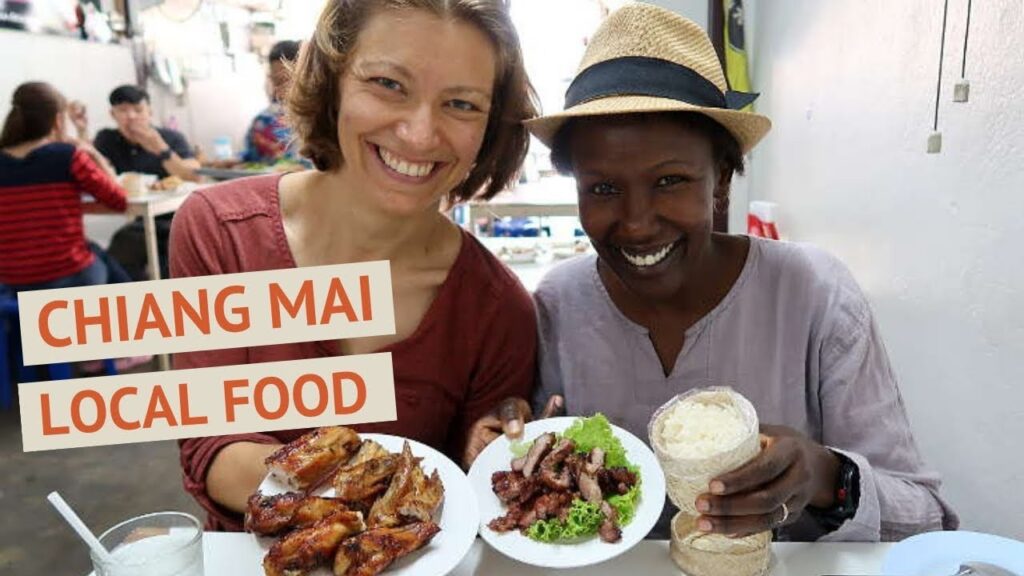
5. Tips for Navigating Chiang Mai’s Street Food Scene
While exploring Chiang Mai’s street food scene, keep these tips in mind to ensure a seamless and enjoyable experience:
5.1 Hygiene and Safety Considerations
When eating street food, it’s crucial to prioritize hygiene and safety. Look for vendors who follow proper food handling practices and maintain clean cooking conditions. It’s also advisable to choose food that is cooked fresh and served hot to minimize the risk of foodborne illnesses. Trust your instincts and observe the cleanliness of the stall and the ingredients being used.
5.2 Communicating with Street Food Vendors
Many street food vendors in Chiang Mai may not speak fluent English, but don’t let the language barrier deter you from trying their delicious offerings. Be patient and use simple gestures or point to what you want. Better yet, embrace the opportunity to learn a few basic Thai phrases to enhance your interactions and show your appreciation.
5.3 Trying New Foods and Overcoming Language Barriers
Don’t be afraid to step out of your comfort zone and try new and unfamiliar dishes. Chiang Mai’s street food scene offers a vast range of flavors and textures that are worth exploring. If you’re unsure about a specific dish or ingredient, ask for recommendations from locals or try observing what others are enjoying.
5.4 Budgeting for Street Food in Chiang Mai
One of the advantages of Chiang Mai’s street food scene is that it offers an affordable dining option. Set a budget for your street food adventures, as it can be tempting to keep trying new dishes. It’s also a good idea to carry small denominations of Thai baht for convenient and hassle-free transactions with street food vendors.
5.5 Using Local Recommendations and Reviews
There are countless street food stalls in Chiang Mai, making it challenging to decide where to indulge your taste buds. Utilize local recommendations, online reviews, and food blogs to guide your culinary journey. Whether it’s seeking out the most flavorful Khao Soi or discovering hidden gems known only to the locals, these resources can help you navigate Chiang Mai’s street food scene with ease.
6. Insights into Chiang Mai’s Food Culture
To truly appreciate Chiang Mai’s street food scene, it’s important to understand the cultural influences and culinary traditions that shape the city’s food culture:
6.1 Influences and Origins of Chiang Mai’s Cuisine
Chiang Mai’s cuisine draws influences from neighboring countries such as Myanmar, Laos, and China, resulting in a unique fusion of flavors. The use of aromatic herbs, spices, and local ingredients like galangal and lemongrass adds depth and complexity to the dishes. Additionally, the region’s mountainous terrain and cooler climate have contributed to the popularity of heartier and spicier dishes.
6.2 Traditional Culinary Techniques and Ingredients
Traditional culinary techniques play a significant role in Chiang Mai’s food culture. From pounding curry pastes using a mortar and pestle to slow-cooking meats in flavorful broths, these techniques ensure the rich flavors are fully developed. Ingredients like dried chilies, shrimp paste, and kaffir lime leaves are essential in creating the distinct taste profiles of Chiang Mai’s dishes.
6.3 Role of Street Food in Local Festivals and Celebrations
Street food holds a prominent place in Chiang Mai’s local festivals and celebrations. During festivals such as Songkran and Loy Krathong, street food vendors set up temporary stalls offering traditional sweets, snacks, and savory delights that are enjoyed by locals and visitors alike. These festivals are an excellent opportunity to experience the joy and camaraderie associated with street food in Chiang Mai.
6.4 Impact of Tourism on Chiang Mai’s Food Culture
Chiang Mai’s street food scene has undoubtedly been influenced by tourism, with vendors adapting to accommodate the tastes and preferences of international visitors. While this has led to the availability of diverse cuisines and fusion dishes, it’s important to seek out the hidden gems and try the more traditional offerings to fully appreciate the city’s culinary heritage.
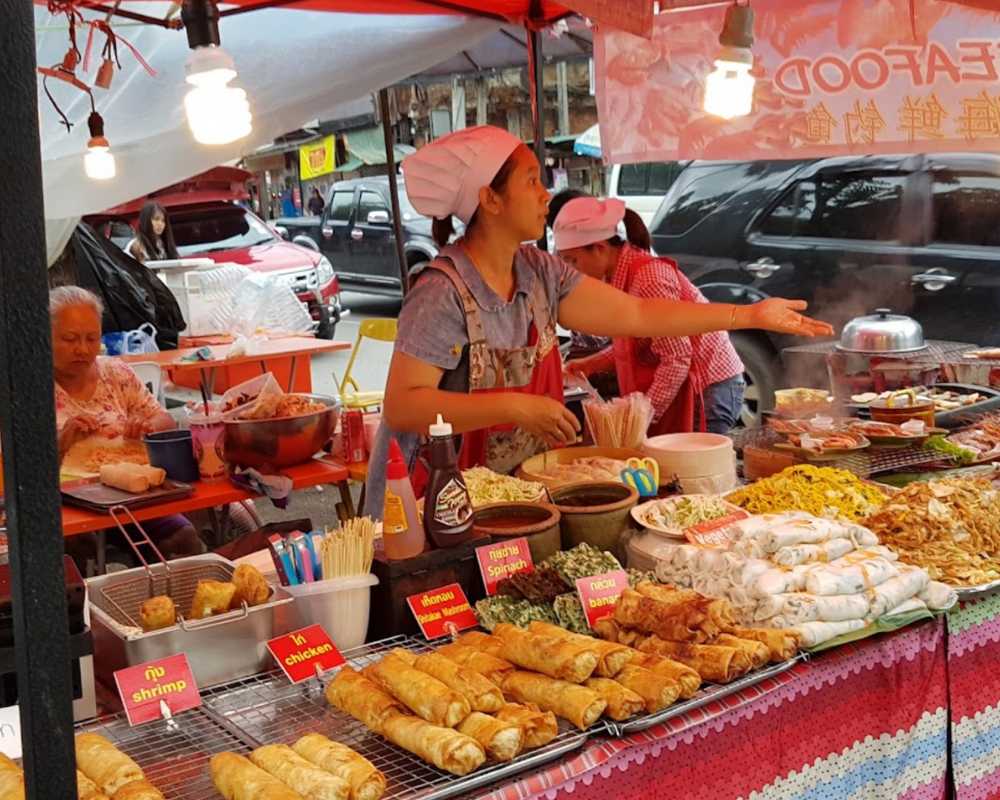
7. Beyond the Streets: Other Culinary Delights in Chiang Mai
While street food takes center stage in Chiang Mai, the city also offers a wide range of dining experiences beyond the streets:
7.1 Exploring Chiang Mai’s Restaurants and Cafés
Chiang Mai is home to an array of restaurants and cafés that cater to all tastes and budgets. From trendy farm-to-table eateries to upscale dining establishments, you can explore a diverse range of cuisines that reflect the city’s cosmopolitan vibe. Whether you’re craving international flavors or seeking modern interpretations of Northern Thai classics, Chiang Mai’s restaurant scene has something for everyone.
7.2 Trying Unique Regional Fruits and Snacks
Chiang Mai’s diverse agricultural landscape provides an abundance of unique regional fruits and snacks. From the exotic and fragrant durian to the tart and refreshing mangosteen, take the opportunity to sample these local fruits and experience their distinct flavors. Additionally, look out for regional snacks such as crispy pork rinds and sweet coconut treats that make for delicious on-the-go snacks.
7.3 Enjoying Chiang Mai’s Coffee Culture
Chiang Mai’s coffee culture is thriving, with numerous coffee shops dotted throughout the city. The local coffee scene is known for its specialty beans sourced from nearby plantations and carefully crafted brews. Take a break from street food and savor a perfectly brewed cup of coffee while immersing yourself in the cozy ambiance of Chiang Mai’s coffee shops.
7.4 Indulging in Traditional Thai Desserts
Thai desserts are renowned for their intricate flavors and vibrant colors, and Chiang Mai is no exception. Treat yourself to traditional delights like the vibrant and fragrant Tub Tim Krob (water chestnut in coconut milk), the creamy and aromatic Bua Loy Nam King (ginger rice balls in coconut syrup), or the refreshing and sweet Thong Yip (golden egg yolk sweets). These desserts showcase the artistry of Thai cuisine and make for a perfect ending to any meal.
7.5 Experiencing Fine Dining and Upscale Gastronomy in Chiang Mai
For those seeking an upscale culinary experience, Chiang Mai offers a selection of fine dining establishments and gastronomic hotspots. Talented chefs fuse Western and Thai flavors to create innovative and artfully presented dishes that showcase the best of Chiang Mai’s produce. Immerse yourself in the elegance of these establishments and indulge in a carefully curated dining experience.
8. Accommodations for Food Enthusiasts in Chiang Mai
To make the most of your food-filled adventure in Chiang Mai, consider accommodations that cater to food enthusiasts:
8.1 Hotels and Resorts with Convenient Food Vendor Access
Many hotels and resorts in Chiang Mai are conveniently located within close proximity to street food vendors and night markets. Staying in these accommodations allows you to easily explore the street food scene without having to travel far. Additionally, some hotels may even offer their own in-house street food stalls or have partnerships with local vendors, providing a curated dining experience within the comfort of your accommodation.
8.2 Guesthouses and Homestays near Local Markets
If you prefer a more immersive experience, consider staying at a guesthouse or homestay near local markets. These accommodations offer a glimpse into the daily lives of Chiang Mai’s residents and provide easy access to fresh ingredients and local street food vendors. The hosts are often well-versed in the local food scene and can offer personalized recommendations and insights.
8.3 Airbnb and Rental Options in Food-Centric Neighborhoods
Chiang Mai’s food-centric neighborhoods, such as Nimmanhaemin and Santitham, are home to numerous Airbnb and rental options. Choosing to stay in these areas allows you to have a wide range of dining options right at your doorstep. Explore the trendy cafés, street food stalls, and local eateries that line the streets of these neighborhoods, ensuring you never have to venture far for a delicious meal.
8.4 Accommodations with On-Site Dining Experiences
Some accommodations in Chiang Mai offer on-site dining experiences, allowing you to savor delicious meals without leaving the comfort of your accommodation. These establishments often collaborate with local chefs to curate menus that showcase the best of Chiang Mai’s culinary offerings. Enjoy a relaxed meal and savor the unique flavors of the region in the serene ambiance of your hotel or resort.
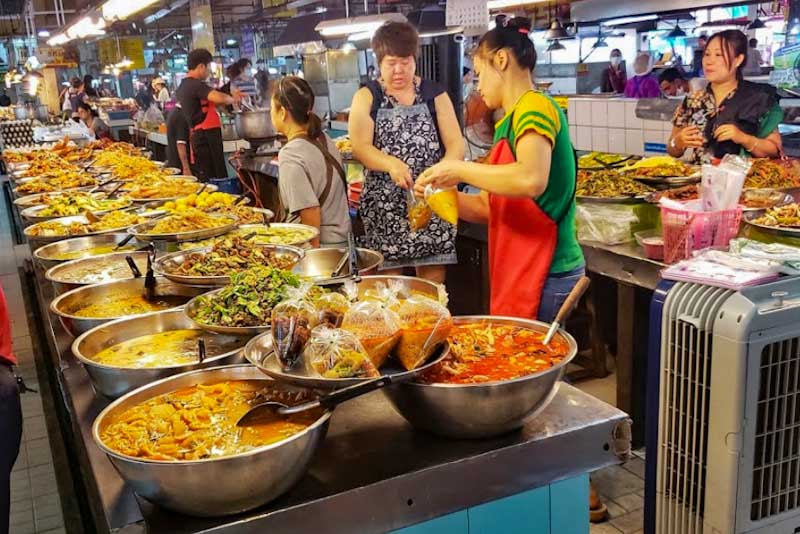
9. Cultural Etiquette for Dining in Chiang Mai
While enjoying Chiang Mai’s street food and dining experiences, it’s important to be mindful of cultural etiquette:
9.1 Removing Shoes and Proper Seating
In some local eateries or when dining in local homes, it is customary to remove your shoes before entering. Keep an eye out for others removing their shoes and follow suit. Additionally, when seated on the floor or at a low table, it is polite to sit cross-legged or with your legs to one side, as this shows respect for Thai traditions and customs.
9.2 Respectful Interactions with Food Vendors
When interacting with street food vendors, it is important to always be respectful and polite. Simple gestures of gratitude, such as saying “thank you” in Thai ( “kob khun kha” for females and “kob khun krab” for males), go a long way in fostering positive interactions. Also, avoid bargaining excessively as street food vendors typically have fixed prices.
9.3 Understanding Thai Table Manners and Customs
Certain Thai table manners and customs should be observed while dining in Chiang Mai. For example, it is polite to wait for the host or the eldest person at the table to start eating before you begin. Thai meals are typically communal, with dishes being shared among the diners. When taking food from a shared dish, use a spoon or fork rather than your hands, as this is considered more polite and hygienic.
9.4 Tipping and Expressing Gratitude
Tipping is not traditionally expected in Thailand, but it has become more common in tourist areas. When dining at restaurants or receiving exceptional service, leaving a small tip as a token of appreciation is a kind gesture. Alternatively, expressing your gratitude verbally or with a smile is also greatly appreciated.
10. Resources for Exploring Chiang Mai’s Street Food Scene
To enhance your exploration of Chiang Mai’s street food scene, here are some recommended resources:
10.1 Recommended Food Blogs and Websites
Food blogs and websites dedicated to Chiang Mai’s street food scene offer valuable insights and recommendations. Seek out popular blogs like “Eating Chiang Mai” and “Chiang Mai Street Food” for detailed reviews and hidden gems. These resources often provide information on must-try dishes, local favorites, and off-the-beaten-path experiences.
10.2 Popular Chiang Mai Food Tours and Experiences
Joining a food tour or experience led by knowledgeable guides is an excellent way to navigate Chiang Mai’s street food scene with ease. Look for reputable tour operators that offer a variety of options, ranging from walking tours through the night markets to guided visits to local eateries and cooking classes.
10.3 Books and Cookbooks on Chiang Mai’s Cuisine
Books and cookbooks dedicated to Chiang Mai’s cuisine are a great way to delve deeper into the culinary traditions and authentic flavors of the region. Titles like “Flavors of Chiang Mai” by Nongkran Daks and “Chiang Mai: Northern Thai Cooking” by Austin Bush provide valuable insights into the origins, techniques, and recipes of Chiang Mai’s iconic dishes.
10.4 Local Maps and Food Guides
Local maps and food guides, available at tourist information centers or downloadable online, can be immensely helpful in navigating Chiang Mai’s street food scene. These resources often include detailed maps of street food districts, recommended vendors, and key landmarks to help you plan your culinary adventure.
